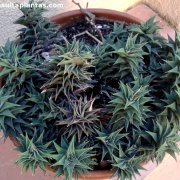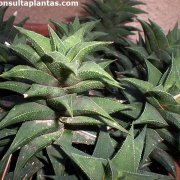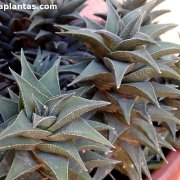Care of the succulent plant Haworthia viscosa or Haworthiopsis viscosa |
|
The genus Haworthia, family Asphodelaceae, comprises 100 species of succulent plants native to southern Africa. Some species are: Haworthia viscosa, Haworthia turgida, Haworthia truncata, Haworthia retusa, Haworthia reinwardtii, Haworthia pumila, Haworthia marumiana, Haworthia limifolia, Haworthia herbacea, Haworthia attenuata, Haworthia angustifolia, Haworthia fasciata, Haworthia cooperi, Haworthia arachnoidea, Haworthia variegata, Haworthia cuspidata. Scientific synonyms: Haworthiopsis viscosa, Aloe viscosa. They are small perennial succulent plants that reach 15 cm (5.9") in height and produce lateral suckers. The fleshy leaves are triangular, arranged in elongated rosettes and can be dark green, olive green or brown in color. The flowers are small, white and appear in inflorescences 30 cm (11.8") in length; they are not decorative. Aloe viscosa is used as indoor, greenhouse or terrace plants in pots that are wider than they are deep. Good ventilation is important so that humidity does not accumulate. Haworthia viscosa requires a dim light or semi-shade exposure; direct sun can burn leaves. It resists well the heat of the Mediterranean summer; in winter it needs to rest at 10 ºC (50 ºF). The soil can be a mixture of indoor plant substrate with 40% coarse sand or a commercial cactus substrate. Aloe viscosa is not usually transplanted very much because growth is slow. In spring and summer, water deeply, always waiting for the substrate to have completely dried. From mid-autumn to early spring, water every 2 months. Fertilize with mineral cactus fertilizer in mid-spring and mid-summer. Haworthiopsis viscosa does not need pruning. Haworthia viscosa is a very sensitive plant to excess humidity. Aloe viscosa propagates easily by separation of suckers; dry for 2-3 days before rooting in a slightly damp sandy substrate. |
Images of the succulent plant Haworthia viscosa or Haworthiopsis viscosa |
Find plants
Haworthia viscosa or Haworthiopsis viscosa | Care and Growing
© 2025 FavThemes



